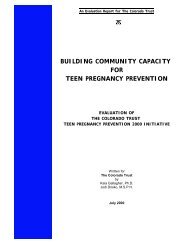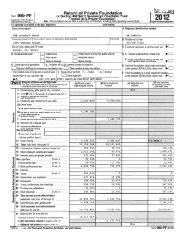After-School Initiative's Toolkit for Evaluating
After-School Initiative's Toolkit for Evaluating
After-School Initiative's Toolkit for Evaluating
Create successful ePaper yourself
Turn your PDF publications into a flip-book with our unique Google optimized e-Paper software.
Appendix III. The Use of Incentives in Evaluation<br />
An ASI program may choose to use incentives as a way of enticing youth to participate in their evaluation or as a way of getting parents to<br />
return consent <strong>for</strong>ms. Incentives are a good way to increase participation and demonstrate that a program values youth participants’ and<br />
parents’ time. One of the downsides of incentives is cost. Also, some researchers argue that incentives may introduce more bias because<br />
they compel participants to answer more favorably due to payment or other reward received or may select <strong>for</strong> specific sub-populations<br />
based on the type of incentive.<br />
Many programs may not need incentives because youth participants and parents are often motivated and place a high value on the<br />
program. In this case it may be unnecessary to provide incentives <strong>for</strong> participation in evaluation activities.<br />
However, some programs may need incentives to help increase participation in their ef<strong>for</strong>ts. If low response rates are expected or become<br />
an issue, incentives can be used to increase participation. Incentives can be used in a variety of ways:<br />
• Advance payment <strong>for</strong> future work: incentives are given to all participants (or parents) asked to take part in the evaluation regardless<br />
of their response. These incentives are often less significant and play more on the “guilt factor” rather than reward people with<br />
reasonable compensation <strong>for</strong> the work per<strong>for</strong>med. (This approach is often used by charitable organization asking <strong>for</strong> donations.<br />
For instance, personalized address labels, pens, a penny, etc. are mailed to motivate people to give.)<br />
• Payment <strong>for</strong> work completed: participants who complete the survey are given an incentive. These incentives are often more<br />
significant such as t-shirts, hats, snacks, bumper stickers, coupons <strong>for</strong> use at a fast-food restaurant, etc. An option <strong>for</strong> programs<br />
with limited budgets is the use of a lottery or drawing. Every participant completing a survey is entered in the lottery to win a prize.<br />
Note that if incentives are paid <strong>for</strong> work completed, there must be a system in place to protect the anonymity or confidentiality of the<br />
respondents (i.e., people cannot be asked to sign the survey so they get their prize). A common way to get around this dilemma is to ask<br />
individuals to turn in a second <strong>for</strong>m indicating the survey is complete at the same time the actual completed survey is returned. The surveys<br />
and completion <strong>for</strong>ms are kept in two different boxes.<br />
Instead of offering money as an incentive, consider alternatives. Some ASI programs have given youth candy (or more healthy treats) as a<br />
reward <strong>for</strong> completing the survey. Others have enticed youth with an end-of-semester pizza party. In any case, program staff needs to make<br />
sure youth understand that their reward is <strong>for</strong> participation in the survey and NOT <strong>for</strong> giving high marks.<br />
<strong>Toolkit</strong> <strong>for</strong> <strong>Evaluating</strong> Positive Youth Development 41










